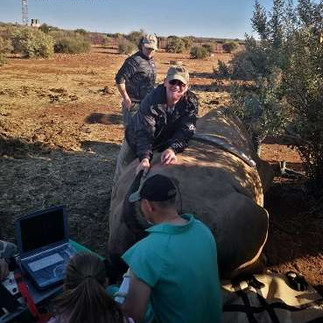OPERATION OOCYTE: IVF FOR RHINOS
- Bateleurs PR

- Jun 28, 2024
- 3 min read
Overview of operation:
An international research centre is funding a critical mission to extract oocytes (egg cells) from rhinos to aid in their conservation. The extracted oocytes need to be swiftly transported to a laboratory in Pretoria, making timely delivery essential. Traditional courier companies cannot provide the immediate, on-site transportation needed, especially from remote bush runways.
The Bateleurs stepped in to handle this IVF FOR RHINOS mission, being the third week-long mission flown for this initiative, the first two being completed at the end of 2023 and early 2024.
The operation involves intricate planning, considering variable weather conditions and the unpredictable nature of the rhinos. The primary goal is to enhance the genetic diversity of the rhino population and to preserve eggs for future use, ensuring the species' survival even in dire circumstances.

IVF FOR RHINOS Article by : Steve McCurrach, Bateleurs
The Bateleurs briefing was to support conservationists with a nimble aviation solution,
where a veterinary team would extract fertile Oocytes (eggs) from rhinos in-field and with
the oocytes being both time and temperature sensitive, to then rush the ‘product’ to a city
veterinary laboratory, where in vitro fertilisation would be practiced.
We had The A Team in attendance, it was not the usual one veterinarian on the animal, but
four of them, each specialist in their field. Seen here at the ‘non working’ end of the rhino is
the constant monitoring of vital signs, BP, temp, pulse, breathing rate, and with any
fluctuations being relayed to the working end.
I don’t even want to tell you of the clearing of the bodily tracts and all I can say is “thank
Goodness the animal was anaesthetised”, but then in went a probe which had every
appearance of a speargun, with some Bats pilots hanging up their flying gloves, to get dirty
and provide shade for the catscan equipment.
The team gathers around to see images of ovary follicles on the PC/scanner and then the
super sensitive harvesting of as many oocytes (eggs) as they could get.
Their excitement upon extracting the oocytes was palpable and visible.
The contribution by Bateleurs pilots always ends up going beyond them only doing the flying
and in this instance pilot Claude was digging trenches to flow away the many litres of
excreted anal douche, with myself doing the highly skilled tail wrap. Don’t laugh, this is
important, because the Vet gets rather upset, when slapped in the face by a faeces sodden
rhino tail, whilst he/she are intent upon their scope.
The work was not without moments of excitement; while waiting for the cow to go down,
her adolescent calf was in attendance at the boma fence and did a few chases of us poor
fellows, who only had a 125cc Honda motorcycle for cover. Then once inside the boma and
with the intense work happening, two fellow rhinos were intent with their curiosity. It took
some sentry duty to keep these fellows at bay and preventing the working Vets from getting
a huge surprise.
Having done the harvest, the eggs/oocytes are placed in an environmentally controlled
container and with thanks to Easy Cockpit navigation, we rushed the precious cargo to the
destination airport and there handed over by The Bateleurs crews.
At this stage the work is very experimental and who knows – maybe rhinos just don’t cope with implanted embryos.
Nevertheless, if successful then this groundbreaking top tech in veterinary science will make
World news. The long term goal is a dreamlike combination of: the host cow is de-horned
whilst having the embryo implanted and what we have arrived at is; a pregnant rhino cow,
with genetically diverse donors and being of no interest to poachers, due to be de-horned.
It doesn’t get better than this in the marriage of aviation and conservation.
















Comments